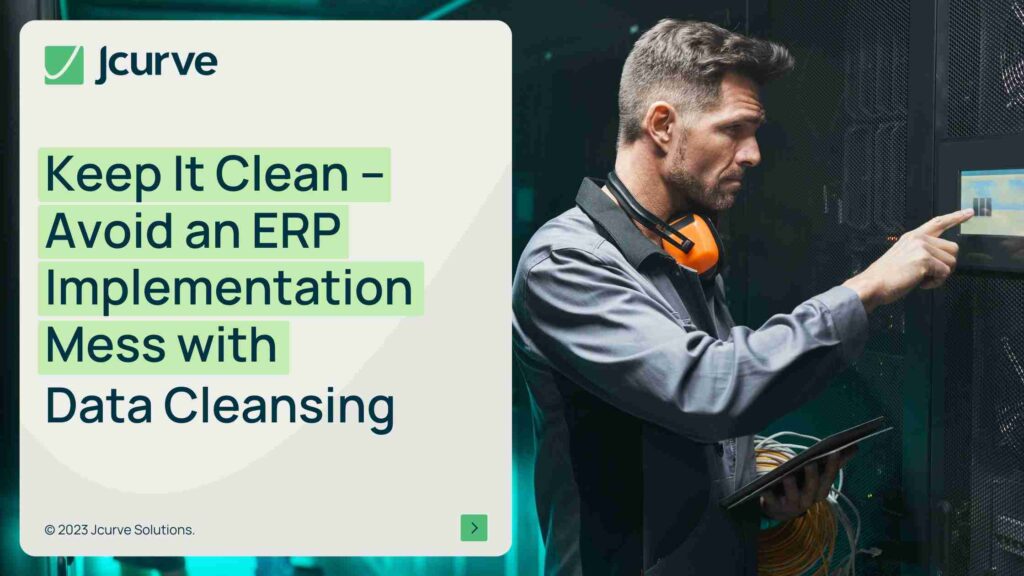There are few of us who genuinely love packing for moving house. It takes focus, organisation and preparation. While you are packing and preparing for the move you come across broken pens in dusty drawers, dishes you never use, and even that old chair in the corner that no one ever uses and has to be pushed and pushed back whenever you want to use the cupboard behind it.
When you start looking into ERP software, preparing to pack up and migrate your business data over to a new ERP system often isn’t the most exciting prospect. But I believe it’s a necessity for any new ERP implementation.
The time you have between deciding on an ERP system and kicking off the implementation is precious and, when used wisely, can make a huge difference to the implementation’s success. It’s a chance for you to clean up data, get rid of old unruly details, cleanse, and correct persistent dust balls that have been stuck in the cogs of your business operations longer than you can remember.
When the implementation starts, it will require significant time and focus. The quiet time before it begins, therefore, can be the perfect time for a spring clean of your current systems and data. Preparing your data, listing issues that need to be addressed, and making sure you start your ERP implementation plan with everything in order can help you hit the ground running. Being prepared will also maximise your investment, and the time spent, in the implementation process.
Here are some squeaky-clean pointers how to avoid potential ERP implementation disaster by getting your data cleansing and preparation right.
Where to tidy up?
 The first step is deciding where you need to tidy up data. Should it be managed within your current systems? Or will you have the chance to do this on your exported spreadsheets of data on the way into your new ERP system?
The first step is deciding where you need to tidy up data. Should it be managed within your current systems? Or will you have the chance to do this on your exported spreadsheets of data on the way into your new ERP system?
As a rule of thumb, I usually suggest tidying up in the source system as much as is practical. This is because, in most cases, working inside your source system maintains data integrity. Writing off old invoices inside your accounting system will keep your balance sheet in line with your debtors, and discontinuing old products within your inventory system will reconcile nicely into your stock value.
If you extract all our data and tell the implementation consultant, “Just leave out all those small amounts”, you could be heading down a rocky road of having data that just doesn’t add up when it’s brought into your new ERP system.
In some cases, it may not be practical to clean up all data in your old systems. After all, that could be part of the reason why you’re moving away from them and starting with afresh with ERP software.
If your team needs to export data to Excel and then manipulate it manually:
- Make sure they are skilled and confident in using Excel. It’s not hard to mess up data when you are working on spreadsheets and you’ll need to take extra care when changing values manually.
- Plan out how you will check that everything adds up. If you have one person making the changes, it’s a good idea to have a different person check over it with a fresh set of eyes. Have a separate sheet with expected value totals and record counts and always check back against it.
- If possible, import the updated data back into your current systems. This can help keep data more aligned between your current systems and your new ERP software until you’re ready to go live.
“As a rule of thumb, I usually suggest tidying up in the source system as much as is practical. This is because, in most cases, writing off old invoices inside your accounting system will help maintain the integrity of your balance sheet, and discontinuing old products within your inventory system will reconcile nicely into your stock value.”
Keep on top of things
 When I help businesses prepare for their ERP implementation, I encourage them to start a project journal. This can be a shared Google Doc, a collaborative Trello board, or any other easy-to-use, always-on tool that your team is comfortable with.
When I help businesses prepare for their ERP implementation, I encourage them to start a project journal. This can be a shared Google Doc, a collaborative Trello board, or any other easy-to-use, always-on tool that your team is comfortable with.
Whenever an issue arises that’s outside of the standard business processes, such as, “Oh, remember the time we messed up a price update and ended up with duplicate products? We need to remember to remove them”, write it down, right away.
When working on data, keeping a journal of key changes made can make sure you don’t end up with discrepancies. It will help tremendously, months later, when you are trying to figure out what happened to a certain item, why we ended up setting up using product hierarchy instead of product classes, or those three key steps we said we’d remember whenever setting up a new employee or running a mass price update.
Google Docs and Trello are a couple of great tool recording notes and decisions, creating checklists for future scenarios, ticking them off as you go, and enabling your team to work collaboratively on changes.
“When working on data, keeping a journal of key changes made can make sure you don’t end up with discrepancies. It will help tremendously, months later, when you are trying to figure out what happened to a certain item.”
What to clean up
Just about every business has an inherent knowledge of past exceptions and issues in the data that your their team is acutely aware of. It goes without saying that these will all be items to resolve during your data clean-up.
Here are some of the more common exceptions that you may not have thought about or may want to explore further:
Products:
- Get rid of negative stock. It’s never a good idea as it’s an indication there’s an error that needs to be corrected. Get your team to figure out the source of the problem and correct it. You will not be able to bring negative stock into any serious ERP system anyway.
- Ledger out-of-balances should also be sorted out and resolved prior to starting with your new ERP software. Ask your accountant to investigate and fix the issue once and for all.
- Products that have no stock and have not been sold in a while. These are the items you may want to either set as obsolete and leave behind or bring across to your new ERP system being marked as inactive.
- Products that aren’t really stock items, such as one-off items, freight, discounts, additional charges, and landed costs. There are usually better ways to handle these types of items in your new system. List them out, and discuss the best way to handle them in your new ERP system with your ERP implementation consultant or implementation partner.
- All the various and inventive uses for which your team has ever used miscellaneous items. Again, get a list together and review it with your implementation consultant to figure out the best ways to handle them going forward.
Transactions:
- All those incomplete or unwanted sales orders that have been left over.
- Any remaining scraps of purchase orders that will never actually be received.
- Any invoices that are still outstanding for one or two cents.
- Quotes that expired long, long ago.
- Credit notes that were never allocated to anything (don’t get rid of the credits of course, just allocate them).
Customers:
- Identify customers with no email addresses. ERP systems rely on emails to communicate orders, receipts, statements, and carry out CRM and marketing activities. Missing email addresses will limit your functionality. Correct them now, or at least identify the issue, be aware of the limitations, and put it on your stage 2 list.
- If possible, merge any duplicates. Just about every business ends up with customer names that were entered with slightly different spelling and with or without their Pty Ltd at the end. If your current system does not have a merging option, see if there is a simple way to leave one of the duplicates behind without damaging data integrity, or take a note to merge them in the new system.
- Customers that haven’t purchase in a long time. Either leave them behind or bring them across either as leads to nurture or as dead leads (do not contact).
- Any information that’s ended up in the wrong fields, such as email addresses in phone number fields, or phone numbers saying ‘Mary’. Some of this incorrect data can fail the import of data into your new ERP software, while others just create a mess being carried over.
What not to do
 I’ve seen many businesses try to do too much during an ERP implementation. For example, one business owner I worked closely with took my advice about it not being the ideal time to implement a new product coding system he had been thinking about.
I’ve seen many businesses try to do too much during an ERP implementation. For example, one business owner I worked closely with took my advice about it not being the ideal time to implement a new product coding system he had been thinking about.
Adding too much into the mix can make things complicated throughout the migration process.
It may also create an unnecessary burden for users who are trying to get familiar with the new system. Having to get used to a new coding system at the same time can sometimes be a little too much change all at once. Making your staff’s experience positive so that they keep excited about the new ERP software can play a big part in the success of the implementation.
There will still be time after your implementation go-live to revisit additional process changes. And, your new ERP system may also be better equipped to handle some of the other changes you have in mind, such as managing product codes in bulk.
Carefully consider the impact of any significant structural or process changes before trying to make them part of the implementation.
“There will still be time after your implementation go-live to revisit additional process changes. And, your new ERP system may also be better equipped to handle some of the other changes you have in mind, such as managing product codes in bulk.”
The Necessity of Cleaning
Just like preparing for a house move, when it comes to an ERP implementation, data cleansing and preparing your data is a necessary part of the process. But taking it one step at a time can ensure it doesn’t end up being an overwhelming task.
Start off by identifying where you need to tidy up the data – will it be done manually in spreadsheets or managed directly within your existing systems?
Be sure to keep a journal of any discrepancies, one-offs or specific situations that your team know about and give them appropriate tools to help them note and collaborate on those issues.
Have a think about some of the common areas for data cleansing you may not have thought about already across your product, transaction and customer records.
And lastly, pay careful attention that you’re not taking on too much during the implementation by adding excessive new structures or processes into the mix.
Taking a well-thought-out approach like this can help give your business data the spring clean it needs. You’ll almost certainly see greater success in your new ERP implementation and maximise your investment, and the time spent, throughout the implementation process and in ongoing improvement thereafter.










